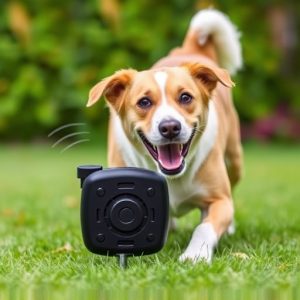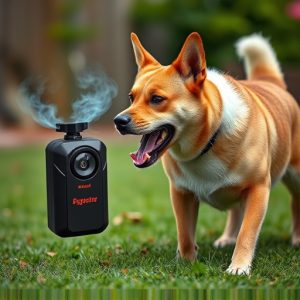Bark Prevention: Electronic Handheld Devices & Optimal Vibration Settings
Excessive dog barking disturbs neighbors, but traditional methods like shock collars are detrimental…….
Excessive dog barking disturbs neighbors, but traditional methods like shock collars are detrimental. An alternative is an electronic bark prevention device using vibration settings to deter barking humanely. By adjusting vibration intensity, owners train their dogs to respond to subtle signals, reducing unwanted barking and fostering peace in homes and communities. The best vibration settings on these devices ensure effective yet safe repellence, with adjustable sensitivity for different scenarios. When choosing, look for models with long battery life, quick charging, water resistance, user-friendly controls, and a clear display for convenient use.
In today’s digital age, managing unwanted dog barking has evolved with innovative solutions. The Bark Prevention Electronic Handheld Device emerges as a modern approach, offering a humane and effective way to curb excessive canine noise. This article delves into the science behind these devices, exploring how they work as powerful dog repellents. We’ll uncover the optimal best vibration settings for maximum effectiveness while guiding you through essential features to consider when choosing your ideal bark repellent device.
- Understanding Dog Bark Prevention: The Need for a Modern Approach
- How Electronic Handheld Devices Work as Dog Repellents
- Evaluating the Best Vibration Settings for Maximum Effectiveness
- Top Features to Consider When Choosing Your Bark Repellent Device
Understanding Dog Bark Prevention: The Need for a Modern Approach
Dogs bark for various reasons, from alerting owners to welcoming them home or expressing anxiety and frustration. While occasional barking is normal, excessive barking can be a nuisance for neighbors and homeowners alike. Traditional methods like shock collars or loud noises often have negative impacts on dogs’ well-being and may cause fear or aggression.
This is where an innovative solution like an electronic bark prevention device comes into play. These handheld devices utilize vibration settings to deter barking without causing harm. By setting the best vibration intensity, owners can train their dogs to recognize and respond to these subtle signals, effectively reducing unwanted barking. This modern approach combines humane training methods with advanced technology, ensuring peace and harmony in both dog owners’ homes and their communities.
How Electronic Handheld Devices Work as Dog Repellents
Electronic handheld devices have emerged as innovative solutions for dog prevention and control, offering a humane alternative to traditional methods. These devices work by emitting specific frequencies or vibrations that disrupt a dog’s behavior patterns, effectively deterring them from unwanted areas. The key lies in the best vibration settings tailored for canine repellence; these settings are designed to target the sensitive hearing range of dogs without causing them harm.
The process involves adjusting the device to emit high-frequency vibrations that are unpleasant for dogs but often imperceptible to humans. When a dog approaches a certain area, the vibrations activate, creating an uncomfortable sensation that encourages them to retreat and avoid the location in the future. The versatility of these devices allows users to adjust sensitivity levels and select specific vibration patterns, ensuring effective control without causing any physical harm or distress to the animals.
Evaluating the Best Vibration Settings for Maximum Effectiveness
When it comes to evaluating the best vibration settings for a dog repellent device, understanding what works best for different scenarios is key. Vibration intensity and frequency play crucial roles in effectively deterring dogs from unwanted areas. For outdoor spaces like gardens or patios, a higher vibration setting with a broader frequency range can be ideal. This ensures that any approaching dog will feel a strong, consistent disruption, encouraging them to stay away.
On the other hand, for indoor use or more sensitive environments, lower vibration levels might be more suitable. Adjusting the device’s settings allows users to tailor the experience while minimizing potential discomfort for humans and pets within the same space. Finding the perfect balance between effectiveness and comfort is essential for a successful dog repellent device, ensuring it performs optimally as a Best Vibration Settings Dog Repellent Device in various settings.
Top Features to Consider When Choosing Your Bark Repellent Device
When selecting a bark prevention electronic handheld device, several top features should be at the forefront of your consideration to ensure its effectiveness and safety for your pet. Firstly, look for devices that offer adjustable vibration settings. The best vibration settings in dog repellent devices range from low-intensity gentle vibrations to high-frequency alerts, catering to different dogs’ sensitivity levels. This adjustability ensures you can find the optimal setting to discourage excessive barking without causing discomfort.
Additionally, consider devices with a long battery life and quick charging capabilities. You want a device that can withstand outdoor usage and last through extended periods of bark monitoring and correction. A water-resistant design is also beneficial, especially if you plan to use it in various weather conditions. Remember to check for user-friendly controls and a clear display, making it convenient to operate during walks or when needed.
In conclusion, electronic handheld devices offer a modern and humane approach to dog bark prevention. By understanding how these devices work and selecting the optimal vibration settings, owners can effectively manage excessive barking without resorting to unpleasant methods. When choosing a bark repellent device, consider key features that suit your needs and ensure it incorporates the best vibration settings for maximum effectiveness in training your canine companion.


